Major Marr and the 1st Anzac Wireless Signal Squadron
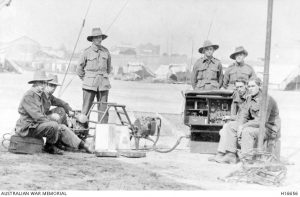
Recruits for the Anzac Wireless Squadron for service in Mesopotamia undergoing training in camp near Sydney. (Donor G. Henderson) May 1916. Courtesy Australian War Memorial
While the troops on the Western Front endured the bitter winter of 1916-1917 in the trenches, Allied soldiers were also battling the Ottoman threat in the Middle East. Mesopotamia (Iraq) is one of the lesser known theatres of the Great War, and the role of Australian troops there lesser known still. From the beginning of the war the British Indian Army was lacking in both wireless equipment and operators. In late December 1915 a request was made to the Australian government to supply a troop of operators to assist. The initial troop – the 1st Australian Pack Wireless Signal Troop – arrived in Basra during March 1916. With reinforcements from Australia and New Zealand they became the 1st Anzac Wireless Signal Squadron later that year.
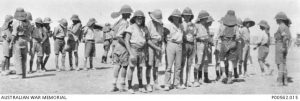
Magil, Basra, Mesopotamia. 1916-07. Informal parade of members of the 1st Wireless Signal Squadron, Mesopotamian Expeditionary Force. Their numbers were depleted because of illness, fatigue due to the unaccustomed heat, and the deployment of some troops to erect wireless stations. Courtesy Australian War Memorial.
After a five-month siege, the garrison in Kut (also known as Kut-el-Amara) fell on 29 February 1916 with the loss of 23,000 British and Indian troops. Historian Christopher Catherwood considered it the worst defeat of the Allies in World War I – worse than Gallipoli.[1] Toward the end of the siege Lawrence of Arabia tried unsuccessfully to bribe the Turkish commander to allow the troops to escape. Instead, 13,000 Allied soldiers were taken prisoner with many dying in captivity.
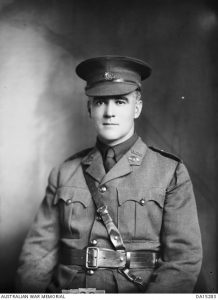
c.17 May 1916. Studio portrait of Captain (Capt) Charles William Clanan Marr, 1st Australian Wireless Squadron. Courtesy Australian War Memorial
Captain (later Major) Charles William Clanan Marr served as the commanding officer of the 1st Anzac Wireless Squadron. Aged 36 at enlistment in 1916, he lived at Limarca, a detached weatherboard cottage at 55 (now 69) Rochester Street Homebush. He had trained as an engineer and had also worked as a telegraph messenger. In 1911 he was appointed foreman at the wireless telegraph station in Pennant Hills.[2] Here he oversaw the construction of a massive 400 foot wireless tower, just in time to be put to good use during World War I.[3]
Marr enlisted at the beginning of April 1916, having only recently moved to Homebush from Pennant Hills. Leaving his wife, Ethel and three young children behind, he embarked for Mesopotamia. His baby daughter, Phyllis had died six months earlier.
In a letter dated 25 July 1916, and published in the Daily Telegraph of 11 September, Marr wrote home about the hardships of life in Mesopotamia: ‘Since our arrival we have averaged 110 deg in the shade… One cannot tell of the hardships suffered by the troops of our Empire in this part of the world. … No work is allowed between 9 am and 5 pm, and one generally lies on the ground in the tent, gasping for breath and keeping a fan going hard, while flies by the thousands try to make friends … Our men bear their trials like good Australians.’[4]

Es Sinn, Mesopotamia. 1916-12-25. Members of the 1st Wireless Signal Squadron, Mesopotamian Expeditionary Force, open tins of Christmas comforts (billies). That is possibly Captain Marr looking on at the back, far right. Courtesy Australian War Memorial.
General Maude, Commander of all Allied Forces in Mesopotamia, led his forces along the Tigris in early 1917, recapturing Kut in February and taking Baghdad from the Ottoman forces on 17 March. The Wireless Squadron made these successes possible with their horse-drawn mobile wireless units enabling communications with headquarters. General Maude acknowledged the importance of their role, saying: ‘Am more than pleased with wireless traffic. It is appreciated to the fullest. Owing to its importance the information cannot be made known. Through being of such importance, it has been cabled to Great Britain and Russia. General Maude wishes to convey his thanks to those concerned.’[5]
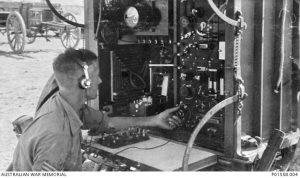
Mesopotamia c.1917. Wireless operator and instrument panel of a horse drawn mobile lorry wireless et used by the 1st Australian Wireless Signal Squadron, Mesopotamian Expeditionary Force. Courtesy Australian War Memorial
According to reports, Marr was one of the first Australians to enter Baghdad [6] and the Wireless Squadron was responsible for installing the first electric light plant in the city. General Maude died of cholera there during November 1917.
Lance-Corporal Farquharson wrote home of the contribution of the Wireless Squadron to the successes of 1917: ‘Just as the Australians won such admiration and renown on other soils so the Australian Wireless has, through its operating abilities, won for Australia a place in the historic annals of the Mesopotamian campaign.’[7]
Of Marr himself, Farquharson wrote: ‘Like all true Australian commanders, he has won for himself a place in the hearts of the whole squadron. The lads look on him as a father and, truly, he is worthy of the title. His ability in providing for the comforts of his men has made the wireless squadron a family circle.’[8]
In 1917 Marr was awarded the Military Cross and, in 1918, the Distinguished Service Order. He was promoted to major and twice mentioned in despatches. He returned home during mid-1918 and youngest son, Victor was born in July 1919, by which time the family had left Homebush. Marr’s hand-written war diaries are now in the collection of the National Library of Australia.[9]
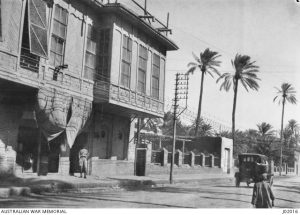
An unidentified soldier standing on the footpath of the building used as the billet headquarters of the Anzac Wireless Unit in New Street, Baghdad. Courtesy Australian War Memorial
In 1919 Marr was elected to Federal Parliament as the Nationalist Member for Parkes, which included Strathfield at that time. The Sailors and Soldiers’ National Federation openly supported Billy Hughes and endorsed a number of former soldiers as candidates, including Marr.[10] He served from 1919-1929 and again from 1931-1943. His positions included Government Whip, Honorary Minister, Minister of Health and Minister for Home & Territories. In 1927 he organised the visit of the Duke and Duchess of York to Australia for the opening of Parliament House in Canberra and in 1929 he led the Australian delegation to the League of Nations. In 1934 he was knighted.
When he died in 1960 the flag that had flown from his headquarters in Mesopotamia was draped over his coffin. He was survived by Lady Ethel, two sons and two daughters.[11]
by J.J. MacRitchie
Local Studies Advisor
References
[1] Christopher Catherwood (22 May 2014). The Battles of World War I. Allison & Busby. pp. 51–2. ISBN 978-0-7490-1502-2 The Battles of World War I – Christopher Catherwood – Google Books[2] Evening News 18 November 1911 p.5 https://trove.nla.gov.au/newspaper/article/115283903
[3] World War One – The Home Front – The Pennant Hills Wireless Station | Parramatta History and Heritage (nsw.gov.au)
[4] Daily Telegraph 11 September 1916 p.4 https://trove.nla.gov.au/newspaper/article/239208515
[5] The Herald (Melbourne) 8 September 1917 p.16 https://trove.nla.gov.au/newspaper/article/242471244
[6] Sunday Times 14 October 1917 p.2 https://trove.nla.gov.au/newspaper/article/122797809
[7] The Herald (Melbourne) 8 September 1917 p.16 https://trove.nla.gov.au/newspaper/article/242471244
[8] ibid
[9] Papers of Charles William Clanan Marr, 1912-1959 [manuscript] | National Library of Australia (nla.gov.au)
[10] Sydney Morning Herald 27 October 1919 p.7 https://trove.nla.gov.au/newspaper/article/15847564
[11] Canberra Times 24 October 1960 p.2 https://trove.nla.gov.au/newspaper/article/103107673
